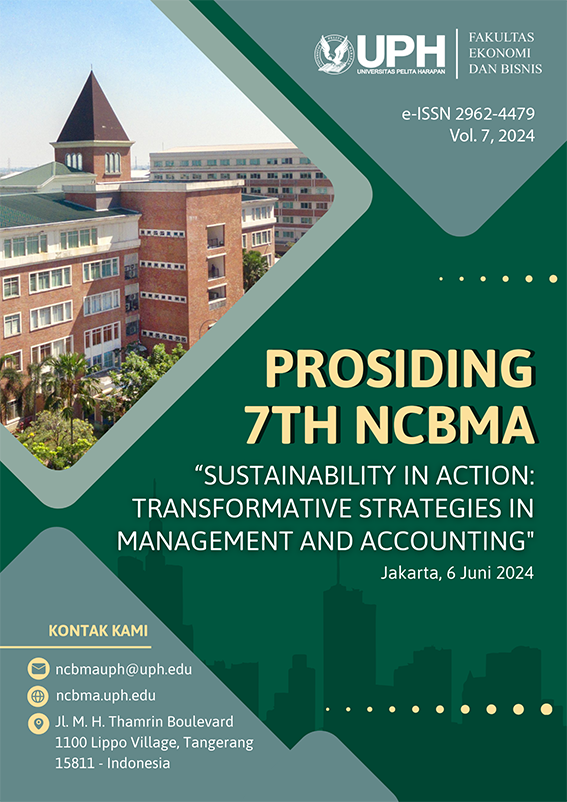WORKPLACE DISRUPTION IN HRM
Keywords:
Workplace Disruption, HRMAbstract
Artikel ini mengeksplorasi fenomena disrupsi di bidang Manajemen Sumber Daya Manusia (SDM). Disrupsi ini dipicu oleh berbagai faktor, seperti kemajuan teknologi, perubahan demografi tenaga kerja, dan globalisasi. Penelitian ini mengkaji dampak disrupsi ini terhadap praktik SDM tradisional dan mengeksplorasi strategi yang dapat digunakan organisasi untuk beradaptasi dengan perubahan ini. Artikel ini menggunakan pendekatan eksplorasi kuantitatif dengan bantuan mesin pencarian Harzing Publis or Perish dan Mendeley melalui penelusuran publikasi di Scopus dalam rentang waktu 2014-2024 yang berkaitan dengan disrupsi di tempat kerja. Hasil penelusuran terhadap lebih dari 200 literatur yang berkaitan dengan disrupsi di tempat kerja menunjukkan bahwa disrupsi memiliki dampak yang signifikan terhadap praktik SDM. Organisasi perlu beradaptasi dengan perubahan ini dengan menerapkan strategi baru, seperti menggunakan teknologi untuk mengotomatisasi tugas SDM, menciptakan budaya kerja yang lebih fleksibel, dan mengembangkan program pelatihan dan pengembangan yang baru. Penelitian yang berkaitan dengan disrupsi di tempat kerja memberikan kontribusi yang signifikan untuk bidang SDM dengan memberikan pemahaman yang lebih baik tentang fenomena disrupsi dan strategi yang dapat digunakan organisasi untuk beradaptasi dengan perubahan saat ini. Penelitian yang mengeksplorasi disrupsi di tempat kerja juga memiliki implikasi praktis bagi para profesional SDM, yang perlu memperbarui pengetahuan dan keterampilan mereka agar dapat beradaptasi dengan lingkungan kerja yang baru.
References
Alkahtani, M., Abidi, M. H., Ahmad, A., Darmoul, S., Samman, S., & Ghaleb, M. (2020). Human Interruption Management in Workplace Environments: An Overview. Engineering, Technology and Applied Science Research. https://doi.org/10.48084/etasr.3404
Bramhani, & Jyothi, D. P. (2019). HR Disruption: Embracing The Digital Future Of HR. Restaurant Business. https://doi.org/10.26643/rb.v118i9.8019
Brown, T. (1988). The workplace revolution: A picture of flexible working 2017. Cities.
Cascio, W. F., & Montealegre, R. (2016). How Technology Is Changing Work and Organizations. In Annual Review of Organizational Psychology and Organizational Behavior. https://doi.org/10.1146/annurev-orgpsych-041015-062352
Creswell, J. W. (2003). Research design Qualitative quantitative and mixed methods approaches. Research Design Qualitative Quantitative and Mixed Methods Approaches. https://doi.org/10.3109/08941939.2012.723954
DeFraia, G. S. (2016). Workplace disruption following psychological trauma: Influence of incident severity level on organizations’ post-incident response planning and execution. International Journal of Occupational and Environmental Medicine. https://doi.org/10.15171/ijoem.2016.746
Eldridge, M., & Newman, W. (1996). Agenda Benders: Modelling the Disruptions caused by Technology Failures in the Workplace. Conference on Human Factors in Computing Systems - Proceedings. https://doi.org/10.1145/257089.257290
Galluch, P. S., Grover, V., & Thatcher, J. B. (2015). Interrupting the workplace: Examining stressors in an information technology context. Journal of the Association for Information Systems. https://doi.org/10.17705/1jais.00387
Grisha, m c, & Nagendrababu. (2020). Challenges and Issues of E-HRM Practices in India. Researchgate.Net.
Kim, P., Cho, W., & Yang, I. (2024). Workplace Disruption in the Public Sector and HRM Practices to Enhance Employee Resilience. Review of Public Personnel Administration. https://doi.org/10.1177/0734371X221095399
Kramar, R. (2021). Workplace performance: a sustainable approach. Asia Pacific Journal of Human Resources. https://doi.org/10.1111/1744-7941.12289
Kropp, B., & McRae, E. R. (2022). 11_Trends_That_Will_Shape_Work_in_2022_and_Beyond 2. Harvard Business Review.
Ludike, J. (2018). Digital employee experience engagement paradox: Futureproofing retention practice. In Psychology of Retention: Theory, Research and Practice. https://doi.org/10.1007/978-3-319-98920-4_3
Madhu, P. (2017). What Is Disruptive Work-Space? SSRN Electronic Journal. https://doi.org/10.2139/ssrn.2882200
Mahapatra, G. P., & Dash, S. (2022). Round Table: Talent development in a changing world of work. IIMB Management Review. https://doi.org/10.1016/j.iimb.2022.03.002
Meister, J. C. ., & Mulcahy, K. J. (2017). The future workplace experience. Soundview Executive Book Summaries.
Microsoft. (2021). The Next Great Disruption is Hybrid Work - Are We Ready? Microsoft 2021 Work Trend Index.
Microsoft Work Trend Index. (2021). The Next Great Disruption is Hybrid Work - Are We Ready? Microsoft 2021 Work Trend Index.
Minbaeva, D. (2021). Disrupted HR? Human Resource Management Review. https://doi.org/10.1016/j.hrmr.2020.100820
Nizzero, A., Cote, P., & Cramm, H. (2017). Occupational disruption: A scoping review. Journal of Occupational Science. https://doi.org/10.1080/14427591.2017.1306791
Nurimansjah, R. A. (2023). Dynamics of Human Resource Management: Integrating Technology, Sustainability, and Adaptability in the Modern Organizational Landscape. Golden Ratio of Mapping Idea and Literature Format. https://doi.org/10.52970/grmilf.v3i2.324
Pachner, T. M., Showalter, K., & Maffett, P. (2022). The Effects of Workplace Support on Workplace Disruptions: Differences Between White and Black Survivors of Intimate Partner Violence. Violence Against Women. https://doi.org/10.1177/10778012211060858
Parry, S. L., Carr, N. A., Staniford, L. J., & Walker, L. (2022). Rebuilding the workplace to promote young workers’ mental health. International Journal of Workplace Health Management. https://doi.org/10.1108/IJWHM-10-2021-0188
Pataki-Bittó, F. (2018). Interruptions at work from the point of view of IT professionals. Periodica Polytechnica Social and Management Sciences. https://doi.org/10.3311/PPso.11857
Schabracq, M. J., & Cooper, C. L. (2000). The changing nature of work and stress. Journal of Managerial Psychology. https://doi.org/10.1108/02683940010320589
Showalter, K., & Bosetti, R. (2021). The IPV-WDA: Developing an Abusive Workplace Disruptions Assessment Using Item Response Theory. Journal of Family Violence. https://doi.org/10.1007/s10896-021-00338-6
Singh, A., & Pandey, J. (2023). Artificial intelligence adoption in extended HR ecosystems: enablers and barriers. An abductive case research. Frontiers in Psychology. https://doi.org/10.3389/fpsyg.2023.1339782
Sivarethinamohan, R., Kavitha, D., Koshy, E. R., & Toms, B. (2021). Reimagining Future of Future by redesigning Talent Strategy in the Age of Distraction and Disruption. International Journal of Systematic Innovation. https://doi.org/10.6977/IJoSI.202106_6(4).0003
Stanley, D. S., & Aggarwal, V. (2019). Impact of disruptive technology on human resource management practices. International Journal of Business Continuity and Risk Management. https://doi.org/10.1504/ijbcrm.2019.10021173
van der Sluis, L., & Barkhuizen, E. N. (2023). Meaning in motion: Evolving images of talent in organisations in a disruptive world. SA Journal of Industrial Psychology. https://doi.org/10.4102/sajip.v49i0.2099
Zhao, D., & Strotmann, A. (2015). Analysis and Visualization of Citation Networks. Synthesis Lectures on Visualization, 3(2), 1-127. https://doi.org/10.2200/s00688ed1v01y201512vis006
Downloads
Published
Issue
Section
License
Copyright (c) 2024 Banta Karollah, Muhammad Zainal Abidin, Muhammad Muhammad, Nurbismi Nurbismi

This work is licensed under a Creative Commons Attribution-ShareAlike 4.0 International License.

